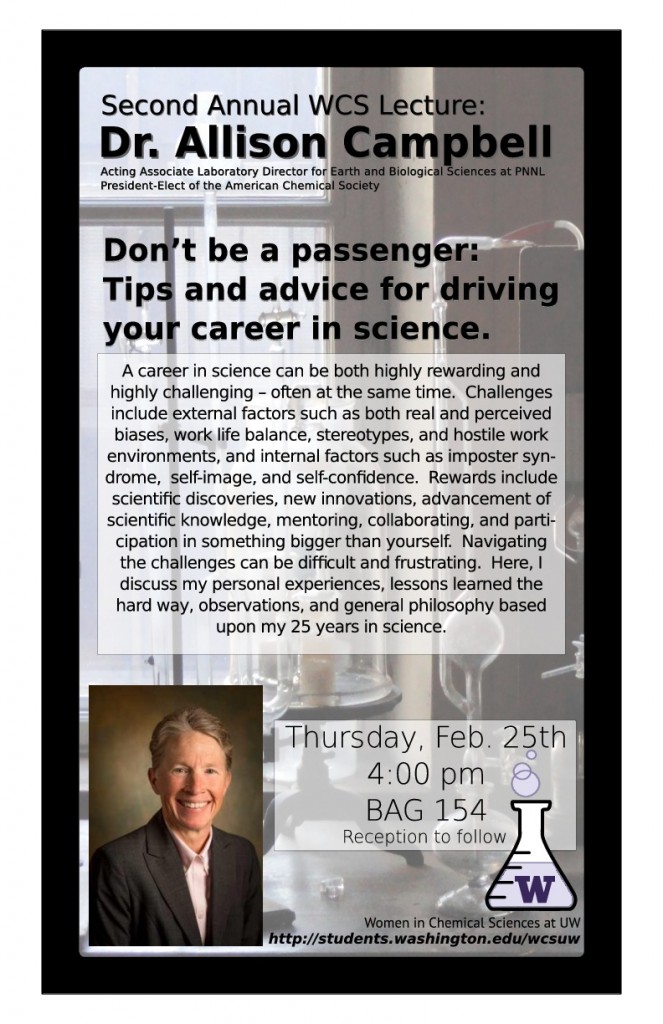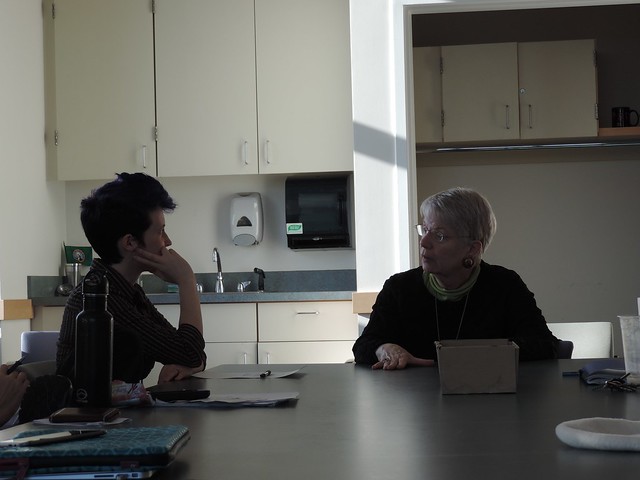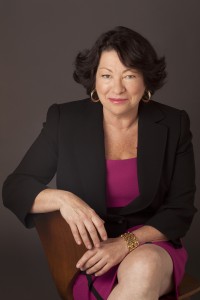Maria Klawe earned her B. Sc. And Ph. D. in mathematics from the University of Alberta. From there, she worked at the University of British Columbia from 1988 to 2002, and then at Princeton University from 2002 to 2006. Dr. Klawe also has experience in industry, working first for IBM and now on the board of directors for Microsoft. Marie Klawe became president of Harvey Mudd College (HMC) in 2006, the first woman president in the college’s then 51 year history.1 As president at HMC, Dr. Klawe has been instrumental in guiding the school to a 1:1 male-to-female ratio from a previous ratio of 2:1. As of 2013, the percentage of female students in the computer science program is 40%, compared to a national average of 12% in 2010-2011.2
Her talk on December 4th was divided roughly into two parts. In the first part, Dr. Klawe described how she went about making HMC a more gender equal campus, and what methods could be employed at UW. During the second part, she took questions, which largely continued the discussion of how to increase diversity, particularly faculty diversity, in the chemistry department.
Obviously, Dr. Klawe’s focus was primarily on improving computer science (CS) at HMC, which was largely dominated by male undergradates. Dr. Klawe attributes the especially dramatic changes in this department to one professor, who in 2005 began pushing to make the department more open to women undergraduates. For ideas, Dr. Klawe drew from example programs at Carnegie Mellon University and University of British Columbia. Unlike other programs, including chemistry, computer science is not a recommended or required high school course. Thus, the range of expertise of students in an intro CS class is large. An integral part of her plan became redesigning the introductory CS courses. The intro CS at HMC is now divided into three skill levels, with students assigned to a level based on a placement test. The names of the programs do not reflect whether the class is for beginner, intermediate, or advanced, which keeps students from despairing of their CS skills before the semester even starts. A second component of the plan was to encourage faculty to mentor students and encourage their growth in CS. If a student was already skilled in computer science, faculty were advised to encourage their interest through individual meetings.
Dr. Klawe then discussed was ways to use these lessons to increase the number of female chemists who apply to academic positions at school like UW. Interestingly, female computer scientists and chemists move on inverse trajectories down the academic pipeline. Although women in CS are less common as undergraduates, their numbers increase at the graduate level; the percentage of female CS academics is higher still. Meanwhile, although men and women chemists are in almost equal numbers as undergraduate and graduate students, the number of male chemists in academia far outweighs the number of female chemists. It has been argued that this difference between fields is because in chemistry the “most desirable jobs” are in academia, while in CS the best jobs are in industry, implying that women are found in lower numbers in the jobs with the most prestige. Regardless of implications, the fact still remains that we have yet to balance faculty gender ratio in chemistry, especially at UW (currently, 5 out of 38 listed faculty members are female).3 This is largely due to the exceedingly low percentage of women who apply for professorships in our department, only 15-20% of all applicants. Since we are a public school, we are supposed to hire men and women in rough proportion to the percentages that apply, and to not give extra advantages to either gender. However, we can try to make UW a more welcoming environment for female professors in chemistry, without needing extra benefits from the department. One example, something that many departments discuss but rarely implement, is emphasizing mentoring skills and teamwork in prospective faculty search profiles. Finding new faculty with these traits will only increase the openness of our department to diversity. Additionally, we can encourage faculty to find a greater work-life balance in their lives, and create a culture that embraces taking time off to start a family. Both of these policies would benefit men and women by creating an open and flexible work environment, and lack of these department policies/ department cultures is oftentimes mentioned as a reason that women leave chemistry academia for industry. Although these don’t seem like high impact changes, if our experience is anything like Dr. Klawe’s then we could use them to significantly change our department environment within the next decade.
The aspect of the talk that I most appreciated was Dr. Klawe’s interest in engaging her audience in a dialogue about women in STEM. Throughout the talk she tried to get contributions from the UW faculty and even the students. As Dr. Klawe stated, the situation for women in chemistry is different from her background in computer science, and she seemed eager to treat her talk as a conversation and a place to generate ideas. She even actively sought out former Harvey Mudd students who were at UW to learn about their experiences as graduate students here. It’s that openness and curiosity, I believe, that has contributed to her success as president at HMC, and makes her advice about expanding diversity extra valuable.
Citations:
- Harvey Mudd College Biography of Maria Klawe
- Computing Degree and Enrollment Trends”, 2010-2011 CRA Taulbee Survey. The Computing Research Association.
- Numbers measured using UW Chemistry Faculty Directory


